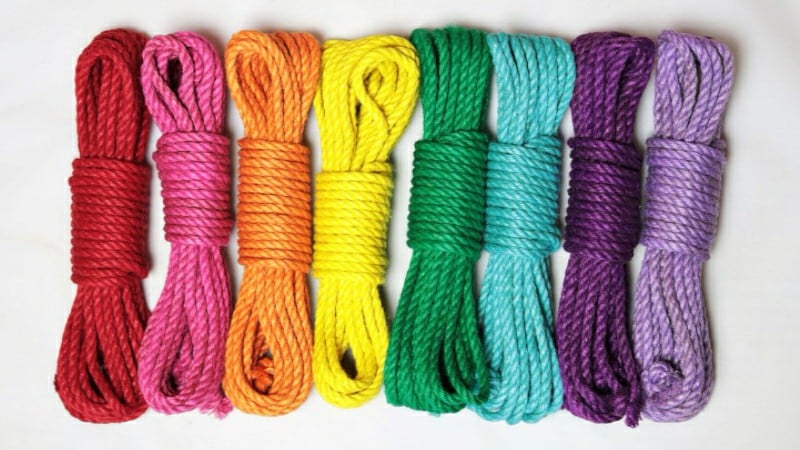If you’re interested in Japanese bondage but have zero idea what it’s about, you’re in the right place. We’re going to look at some brief history, erotic elements, and what to keep in mind before learning how.
First, let’s try to sort out some terminology and wade the confusion around it.
- Kinbaku (緊縛) – tight binding
- Kinbaku-bi (緊縛美) – the beauty of tight binding
- Shibari (縛り) – Decorative tie
- Nawashi (縄師) – A maker of rope – A rope artist in BDSM
Some people differentiate the terms Kinbaku and Shibari (one having BDSM or sexual tones and the other not).
SHIBARI simply means a beautiful knot, like you would make a piece of art or an adornment to a gift.
KINBAKU, however, refers to the aesthetic nature of binding someone – aka. Japanese bondage.
But…
Many Japanese practitioners use the terms interchangeably AND westerners have mistakenly adopted the word Shibari to have sexual overtones.

There is also another point of view of Shibari being erotic because of the study of the knots themselves and the history or ritual behind them while Kinbaku is erotic through functionality and bondage.
So what we have is a muddled mess of language.
BEAUTY AND HISTORY
The ancient Japanese took their knots quite seriously.
- Armor consisted of wooden panels tied together
- Shipped goods were wrapped and secured in cloth
- Gifts were interracially wrapped with cords
- Kimonos were ritualistic (and functional) knots/folds around the body
One of the most interesting things came from the local authorities…
There weren’t jails in the traditional sense, so prisoners were tied up – often with a certain colored rope that corresponded with the particular season and direction.
KINDS OF ROPE

There are two kinds (synthetic and natural), with each type having their own pros and cons. There are also considerations towards stretch, texture, color, and other factors.
Also, certain riggers (the person who does the tying) will insist there is only one “right” thing to use etc.
As long as the practices are safe, there are really no rules for rope material.
Want to know more about rope materials? Start here:
Bondage Rope 101 -12 Useful Tips and Extensive Rope Rundown
THE EROTICISM

The answer to “why” people enjoy this form of bondage varies from person to person.
Some love the looks of rough rope against smooth skin or appreciate the hard angles against soft curves. Others enjoy the art from a bondage aspect and uncomfortable or asymmetric positions a model holds.
Then there’s the enjoyment from the knots themselves and turning their model into a pure, naked work of art.
Daniel Kok, a Singaporean Shibari artist stated it beautifully, “It can be very gentle, as well as really hard. There is a whole range of emotions that are as flexible as the material itself … a sense of communication through rope.”
HUNDREDS OF PATTERNS AND DESIGNS
You have your basic knots and basic functions – things like handcuffs or arm binding. However, things can get really complicated and creative – with some rigs taking HOURS to weave and then take apart. Also, some of the names don’t refer to the finished products of the knots themselves but from the positions the “rope bunnies” take (bunnies = the person tied up).
For example, this image from Rope-topia.com is called “The Shrimp”

After that, there’s hanging shrimp, reverse shrimp, and altered shrimp.
Kinbaku not only can make you horny but apparently hungry.
LEARNING HOW
It is possible to start on your own by learning some basic knots. There are plenty of youtube vids and other resources out there. If you NEED to test them on someone, make sure things stay super loose – and no suspension.
After that, you’ll need to find formal classes. They’ll be in many major cities and some medium-sized ones. It’s always a good idea to check out the instructor before signing up, to make sure they are legit.
And when I say legit, I mean someone with a significant amount of experience and the correct mentality.
Why?
Although the act of tying someone up can be fun, the rigger needs to be aware of so many things:
- Using the correct kind of rope for the knot or function
- Knowing how to make “on the fly” adjustments
- Decent knowledge of anatomy and location of nerve centers
- Different bodily sensations and what they mean
- Knowledge of possible dangers
- Clear communication skills
- Ability to monitor mental and emotional states
- Basic first aid
- At least a minimal amount of empathy
. . . . . . . . . . . . . . . . . . . .
Also, if you liked this article, you might enjoy these:
- What is a Safe Word? Learn the Basics of Kink Communication
- Erotic Spanking – Learn How to Properly Paddle That Posterior
- Cheap BDSM Equipment from Dollar, Thrift, and Hardware Stores
Have you ever been a bunny? How about a rigger? What were your experiences? Maybe you’re interested but have never tried? What positions or “work of art” would you like to be turned into?


